Mikel Arteta’s side haven’t entertained like they did in 2022-23, but they are on course to build a more sustainable title challenge than they did last season.
This season, Arsenal are different.
There are some similarities with this stage of last season, not least in the fact that, after 13 games of 2022-23, they were also top of the league (though they were two points ahead of Manchester City rather than one this season).
But things also felt rather more positive for the club.
That isn’t only because they were performing so high above expectations last year, top of the league when even a top-four finish would have been deemed a success, while this season the fans expect a title challenge. That is playing a part, of course, but it isn’t the only reason.
Arsenal only have a marginally worse record this time around, having won nine, drawn three and lost one of their 13 games so far (30 points), compared to 11 wins, one draw and one loss last season (34 points). No right-minded fan would complain about the position they find themselves in and that’s because Arsenal are in fantastic shape. They could be set for a better title challenge than they managed last season.
But while last season it felt like Arsenal were an unstoppable boulder careering down a hill, blasting anything and everything out of their way, this season they are rather less ruthless, less fluid in their play, and just less exciting.
It has been well documented that their attacking numbers are down across the board. They are averaging 2.08 goals per Premier League game compared to 2.32 last season, while their expected goals per game have dropped to 1.78 from 1.93 and they are having fewer shots, too, with 14.5 per game, down from 15.6.
Anyone watching Arsenal will see a team that looks less fluent with the ball than they did last season. The disjointed performance in Saturday’s win at Brentford – a narrow 1-0 victory that came courtesy of a very late Kai Havertz header – was nothing new. Arteta made the point afterwards that it is impossible to “have a fluent game here” because of the way Brentford play, but we have nonetheless become accustomed to seeing Arsenal toil in the field more often than they blow their opponents away.
It was their fifth single-goal victory in the Premier League this season, and it was typically unconvincing, just like the 1-0 win at Crystal Palace and the 2-1 home win over Nottingham Forest. Three of their other four wins have come against teams in the league’s bottom four – 4-0 vs Bournemouth (17th), 5-0 vs Sheffield United (bottom) and 3-1 vs Burnley (19th) – and their other victory was the 3-1 against Manchester United, secured with a 96th-minute Declan Rice winner and then the second-latest goal on record in the Premier League (since 2002-03), clocked by Gabriel Jesus at 100 mins 15 seconds. It’s fair to say it hasn’t exactly been as impressive as the class of 2022-23 were, even if there have been big statements such as the win over Manchester City.
A lack of fluency has led Arsenal to become even more reliant this season on set-pieces than they were last. In 2022-23, 17.1% of their goals came from corners or free-kicks, with their total of 15 set-piece goals topped by only three other clubs. This season, they have already scored eight – the most in the Premier League, and a massive 29.6% of their overall total. Obviously, that isn’t a problem, per se, but alongside their travails in open play, it points to a team that isn’t functioning to their full capabilities.
In open play, they have scored only 12 goals – fewer than 11 other teams, including Nottingham Forest, Chelsea, West Ham and Bournemouth. They also rank 12th for xG in open play (13.8), with Everton and Brentford among the teams ahead of them, suggesting that their poor goal return in open play is roughly deserved.
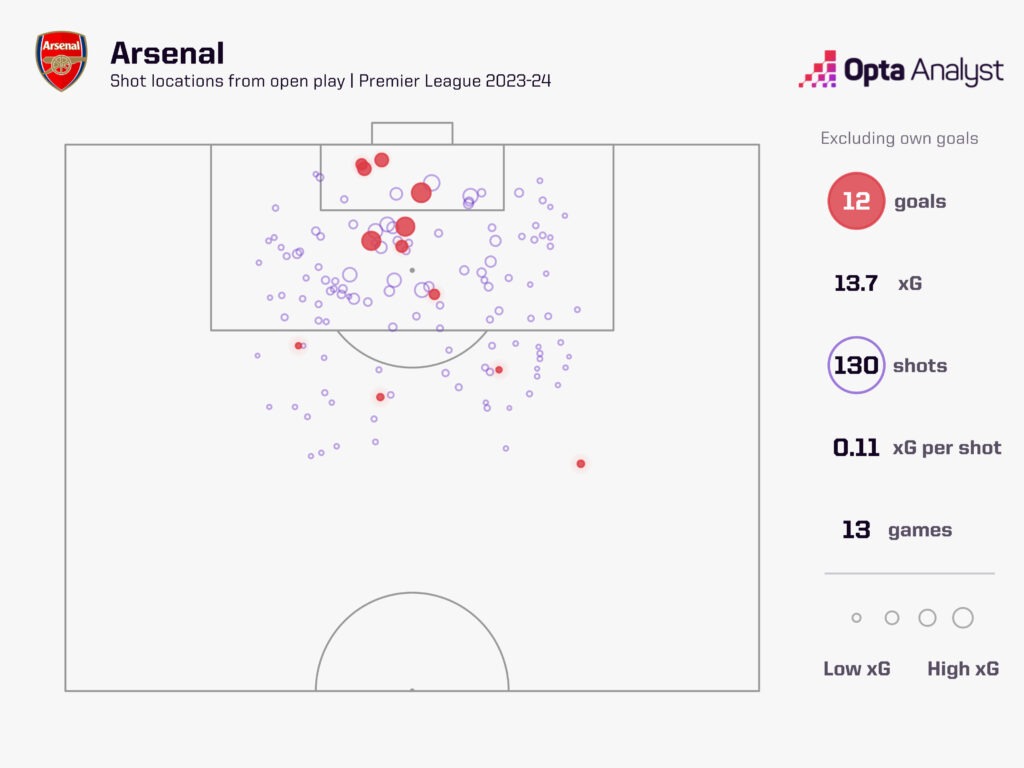
They have also been helped by a league-high six goals from the penalty spot this season, which is at least two more than every other team and twice as many as Arsenal scored last season. Only two teams scored more than six penalties in the whole of 2022-23 (Man City, 9 and Brentford, 7). Without those six penalties this term, Arsenal would have four fewer points.
Arsenal rank 10th in the league this season for non-penalty xG (18.4). For all the talent they have in their ranks, they have underwhelmed in attack this season.
A big part of the problem has been the drop in influence that Martin Ødegaard is having on games. Their captain plays a crucial role for the team, both in and out of possession, and opponents have started to realise that stopping him is very often the key to stopping Arsenal – or at least reducing them to a lesser being in open play.
Ødegaard plays almost every minute when he is available, and he maintained an astonishingly consistent level of performance in 2022-23 despite playing a vast amount of football. He started 37 of 38 games, scored 15 goals and added seven assists, while knitting together much of what they did with the ball going forward.
This season, the Norwegian is getting on the ball marginally less than he did, averaging 60.6 touches per 90 compared to 63.9 last season but, as the below graphic shows, he is touching the ball far less in the most dangerous parts of the pitch.
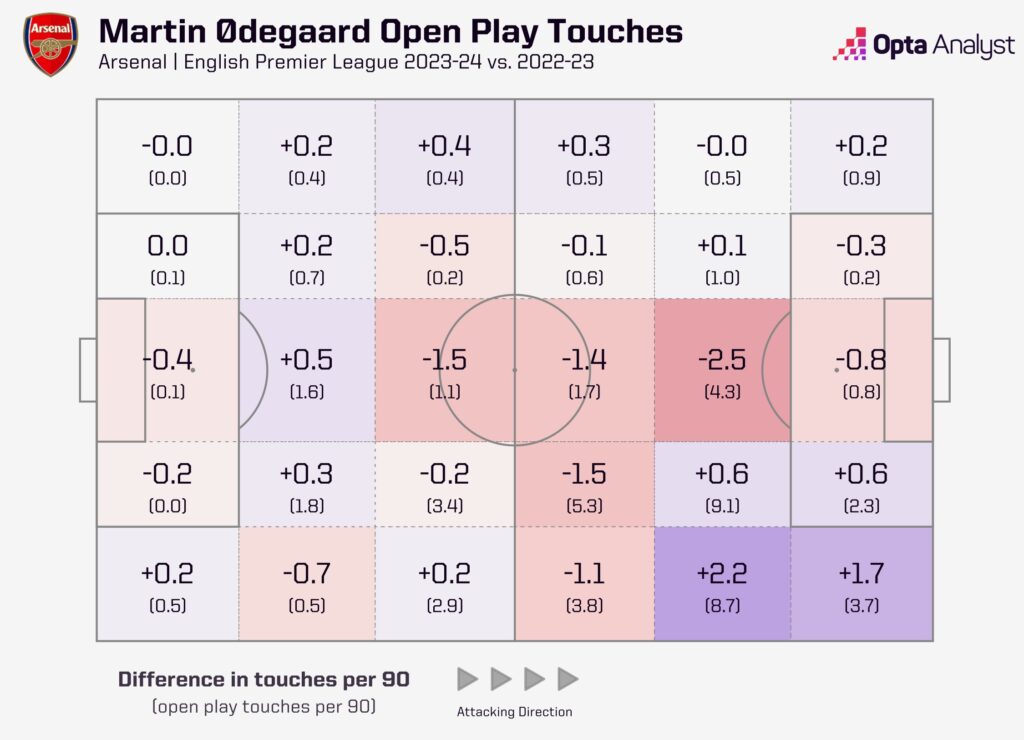
His touches per 90 have dropped significantly in Zone 14 – on the edge of the penalty area – and his touches are down in all advanced, central areas. Meanwhile, he has been getting on the ball more frequently out near the touchline on both sides of the pitch. In other words, he is on the ball further from goal more often than before.
It follows that he is having fewer shots (2.2 per 90, down from 2.7) and scoring fewer goals (0.31 per 90, down from 0.43). He is also assisting goals half as frequently, as well, with 0.10 assists per 90, down from 0.20.
It was always going to be difficult to maintain anything like the levels he did for the whole of last season, and he has had a couple of injuries that have made doing so even harder.
There have also been changes in personnel in the team that have affected Arsenal stylistically. Declan Rice has been an overwhelming success since his £100m move in the summer, but for all his exceptional off-the-ball work (more on that to come), he doesn’t quite offer the same progressive passing ability as the player he replaced at the base of midfield, Thomas Partey. Rice is passing to Ødegaard in open play 4.7 times per 90 minutes this season; Partey did so 6.2 times last season. This might in part at least explain why Ødegaard is getting on the ball in dangerous central areas less often. Partey fed the ball through to him more often and in better positions than Rice does.
Ødegaard is particularly important in getting the ball out wide to dangerman Bukayo Saka on the right wing quickly and efficiently. Only right-back Ben White passed to Saka more times last season than Ødegaard, who was integral to helping Saka isolate the opposition’s left-back at every opportunity. Last season, Ødegaard’s passes to Saka were 13.7m in length, and that has dropped to 11.3m this season, showing that the Arsenal captain is closer to Saka this season, which reduces the likelihood of Saka being found in space.
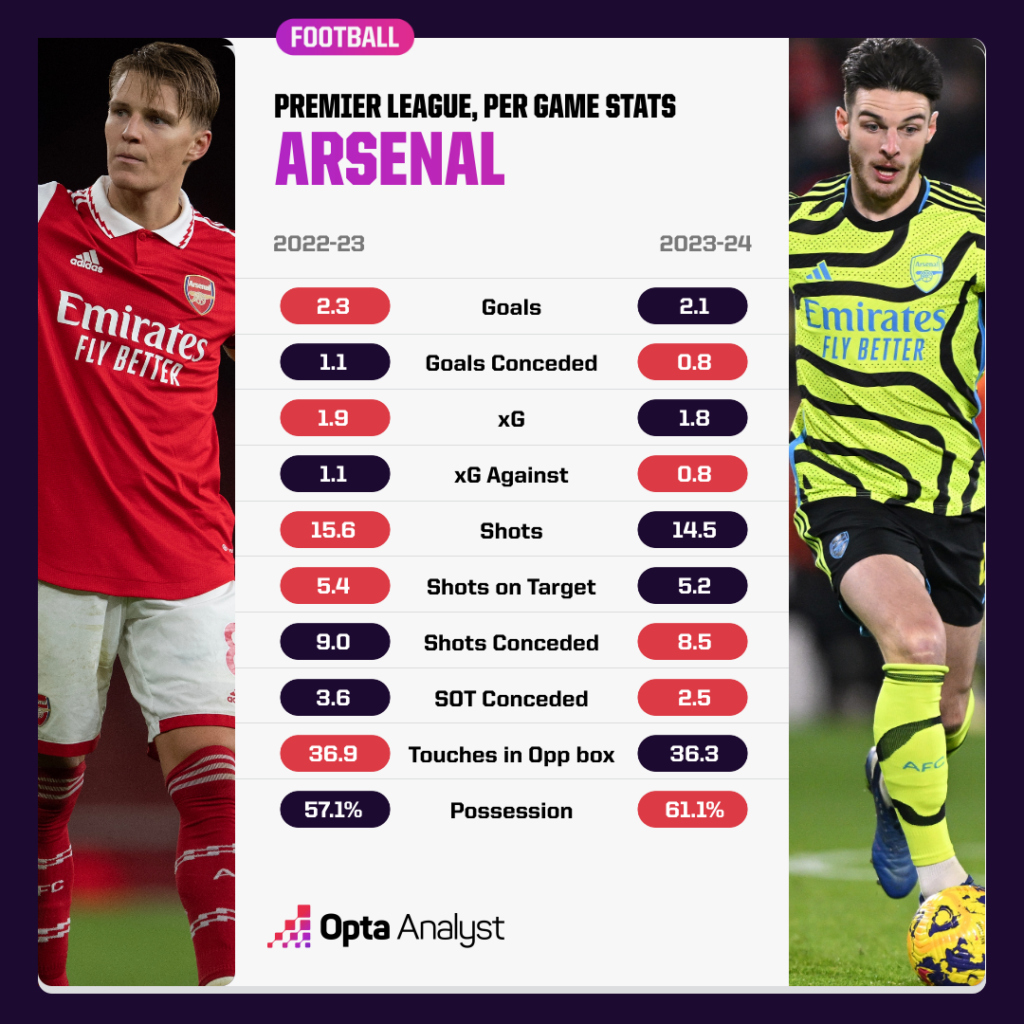
Fortunately for Arsenal, Saka is so good that it doesn’t matter if the service to him isn’t as efficient and he isn’t found in space every time he gets the ball. He was sensational last season, and his output has gone up this term. He has nine goals (five) or assists (four) in 12 Premier League appearances already this season (0.8 goal contributions per 90), having registered 25 in 38 appearances last term (0.7 per 90).
When you have a player like Saka who can produce a killer moment such as his cross for Havertz’s winner at Brentford, or the pass to Leandro Trossard for his winning goal in the 1-0 victory at Everton, or his perfect cross for Trossard to score the equaliser at Stamford Bridge, any lack of fluency as a team is felt less.
It also helps that Arsenal have improved so much defensively. Having shipped just 10 goals this season, they have the best defensive record in the Premier League.
Arteta places great importance on his team’s out-of possession work. Former Arsenal player and coach Freddie Ljungberg noted on Sky Sports’ Monday Night Football this week how important defensive transitions are to Arteta, with whom he used to work.
“Knowing Arteta, I know when they have the ball, it’s very important what the defenders or defensive midfielders are doing to be ready for the transition,” he said. “If you play a game where you want a lot of possession, you know the most vulnerable you are is when people go at you in transition.”
The addition of Rice has meant opposition counters are snuffed out effectively. He covers a vast amount of ground, hoovering up loose balls, pressuring the opposition’s play towards the touchline and making tackles and interceptions. The result is that Arsenal have allowed their opponents to reach the final third on transition fewer times than any other team in the Premier League this season (10.0 times per game).
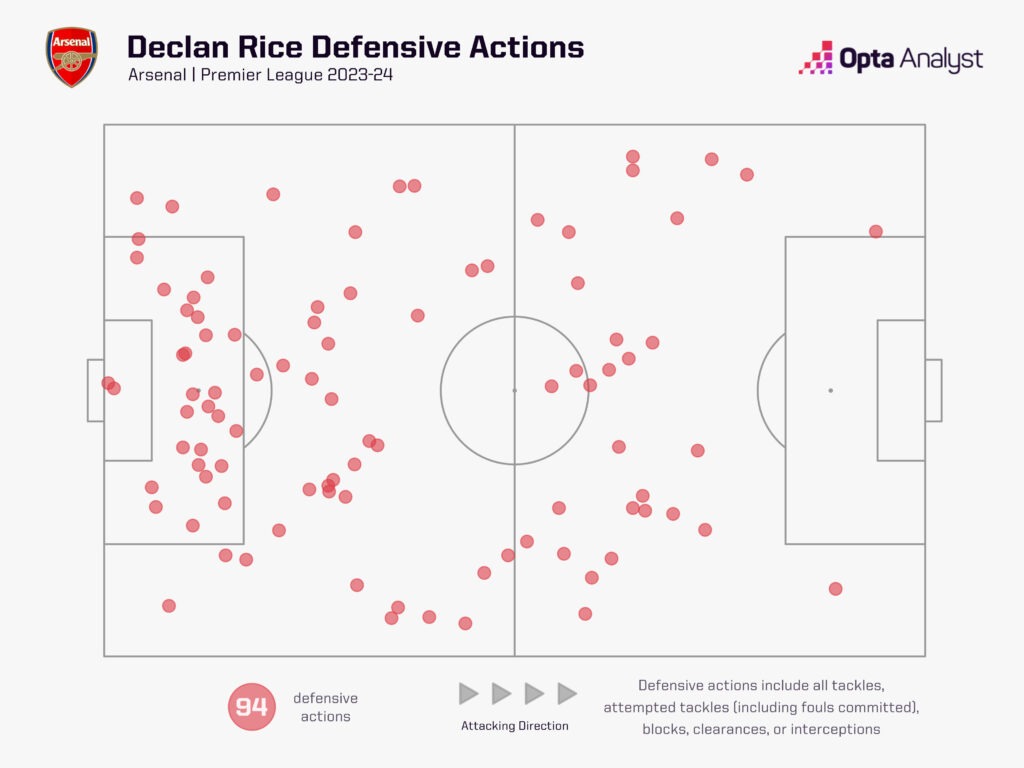
Rice is among the chief reasons Arsenal have been so good without the ball. They are conceding fewer shots this season than last (8.5 per game, down from 9.0) and fewer shots on target (2.5 per game, down from 3.6). They have allowed their opponents fewer expected goals than every other team in the league (10.6), conceding 0.8 per game, which is down from 1.1 last season. It may not sound like much, but that really is a significant reduction – over the course of a 38-game season, that difference of 0.3 per game amounts to 11.4 expected goals in total. Eleven fewer goals conceded would be a massive improvement; one that might make the difference between, say, finishing second and finishing first. A solid defence is the bedrock of a good title challenge and Arteta knows it.
He also deserves praise for how good Arsenal have been at defensive set-pieces. They have conceded only one goal from set plays, and have allowed their opponents just 1.56 xG at set-pieces. Both are the lowest tallies in the league, and paint a picture of a rather different Arsenal from teams of the past.
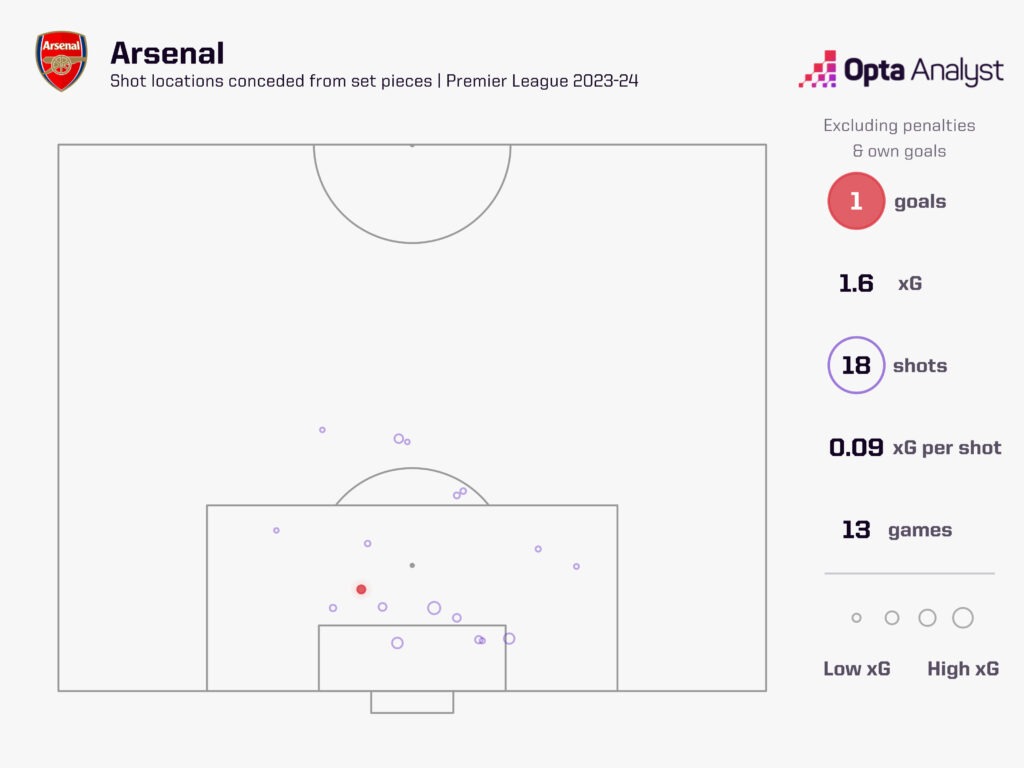
He has clearly prioritised defensive improvement. Why wouldn’t he when his team scored 88 goals in 38 games last season, but conceded 43?
It’s always been important to him anyway. It’s why he signed a pressing forward who scores the odd goal in Gabriel Jesus rather than a goalscorer who can also press.
He will presumably be delighted with Arsenal’s defensive numbers this term, even if it has meant a sacrifice in goals scored and entertainment value for the fans.
His side’s defensive solidity means that any failings in attack are essentially insignificant. Arsenal might not right now be the team they were or the one they aspire to be eventually, but they are top of the league once again and better prepared than last season to mount a proper, sustainable title challenge.
Enjoy this? Subscribe to our new football newsletter to receive exclusive weekly content. You should also follow our social accounts over on X, Instagram, TikTok and Facebook.
